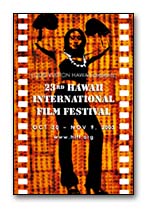
COURTESY OF HIFF
Los Zafiros,
the hottest group
you never heard
Imagine a male vocal group that combined Latino rhythms with doo-wop style harmonies, the sound of the Platters and Motown-style choreography. That was Cuba's Los Zafiros (The Sapphires), and this documentary on the quintet's meteoric rise and inexplicable demise quickly proves the point that they were quite possibly the hottest group Americans never got to hear back in the 1960s.
Vintage performance footage shows that these guys had everything they needed to become internationally famous pop stars: good looks, charisma, great vocals and smooth choreography. Considering Kyu Sakamoto topped the charts for three weeks in 1963 with the Japanese-language "Sukiyaki" and that Ray Barretto had a hit with "El Watusi" that same year, it's no stretch of the imagination to think that Los Zafiros could've hit it big as well. But, of course, by 1963 the United States had placed an embargo on all things Cuban. If only we had known.
'Los Zafiros -- Music from the Edge of Time'
Part of the Hawaii International Film FestivalScreens 3:30 p.m. tomorrow and 6 p.m. next Friday at the Doris Duke Theatre, Honolulu Academy of Arts
Admission: $8 adults; $7 children, military, students and seniors 62 and older; free to festival Ohana members
Call: 528-3456
The memories of the two surviving Zafiros, high tenor Miguel "Miguelito" Cancio and guitarist/arranger Manuel Galban, provide the foundation for director/producer Lorenzo DeStefano's fascinating retrospective. Longtime friends of the band, family members, fellow entertainers and fans add their insights on what made Los Zafiros unique in Cuban music and a world-class act by any standard.
Cancio tells the story of the ring that provided the inspiration for the group's name (they almost dubbed themselves the Fakirs) and eloquently expresses his mixed feelings about living in exile in Miami. Fortunately, this is the 21st century, not 1963, and most of the footage that makes this movie more than a rote VH-1 "where are they now?" piece covers Cancio's return to Havana for a reunion with Galban and the surviving relatives of fellow Zafiros Ignacio Elejalde, Leoncia "Kike" Morua and Eduardo "El Chino" Hernandez.
Some of what transpires during the visit will probably remain opaque to Americans unfamiliar with Cuban culture, but the sentiment that percolates through the reunion scenes transcends language and cultural barriers. Many tears are shed as old friends meet and recall good times together.
Cancio and Galban revisit the streets and local bars where the group is still remembered, and an impromptu performance is one of the film's magic moments -- another is a formal recording session in the studio where the original group once recorded.
Exactly what happened to Los Zafiros after they successfully toured Europe in the mid-'60s is never explained beyond an outsider's comment that they "became dizzy" (a Cuban term that apparently describes someone who can't handle sudden fame and success).
What DeStefano makes clear is that Cubans still cherish the music of Los Zafiros and that a successor group, Los Nuevos Zafiros, founded by Hernandez shortly before his death, is perpetuating their style of music for a new generation, even though the original group is, in fact, forever irreplaceable.
Anyone and everyone interested in Latin music, world music and classic American pop and soul music should make time to see this film. With any luck, there'll be a soundtrack album from this as well.
Click for online
calendars and events.


